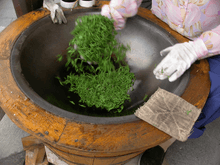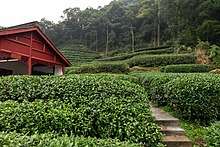Longjing tea
Longjing tea (simplified Chinese: 龙井茶; traditional Chinese: 龍井茶; pinyin: lóngjǐng chá; Cantonese Yale: lung4 jeng2 cha4; Standard Chinese pronunciation [lʊ̌ŋ.tɕìŋ.ʈʂʰǎ]), sometimes called by its literal translated name Dragon Well tea, is a variety of pan-roasted green tea from the area of Longjing Village in Hangzhou, Zhejiang Province, China. It is produced mostly by hand and renowned for its high quality, earning it the China Famous Tea title.
| Longjing tea 龍井茶 | |
|---|---|
 | |
| Type | Green tea |
| Other names | Dragon Well tea |
| Origin | Hangzhou, Zhejiang Province, China |
| Quick description | Very gentle and sweet, these teas can be quite expensive. The tea leaves can be eaten after infusion. |
|
|
Production and health benefits

Like most other Chinese green tea, Longjing tea leaves are roasted early in processing (after picking) to stop the natural oxidation process, which is a part of creating black and oolong teas. The actions of these enzymes are stopped by "firing" (heating in pans) or by steaming the leaves before they completely dry out. As is the case with other green teas (and white teas), Longjing tea leaves experience minimal oxidation. When steeped, the tea produces a yellow-green color. The tea contains vitamin C, amino acids, and, like most finer Chinese green teas, has one of the highest concentrations of catechins among teas.
Quality
The tea can be very expensive,[1] and the prices depend on the varieties, of which there are many.[1] Longjing is divided into six grades: Superior and then 1 down to 5. Infused leaves are a good indicator of quality, which is characterized by maturity and uniformity of the shoots harvested for processing. High quality Longjing teas produce tender, whole leaves that are uniform in appearance. Lower quality varieties may vary in color from bluish to deep green after steeping. Before infusion, higher quality Longjing teas have a very tight, flat shape and light green color. A study by Wang and Ruan (2009) found that one aspect of the perceived low quality of Longjing teas was a higher concentration of chlorophyll, producing a darker green color. The study revealed that free amino acids and theanine concentrations contribute positively to what is perceived as a good taste.[2]
Legends
Longjing tea was granted the status of Gong Cha, or imperial tea, in the Qing dynasty by the Kangxi Emperor. According to the legend,[3] the Kangxi Emperor's grandson, the Qianlong Emperor, visited West Lake during one of his famous holidays.
He went to the Hu Gong Temple under the Lion Peak Mountain (Shi Feng Shan) and was presented with a cup of Longjing tea. In front of the Hu Gong Temple were 18 tea bushes. The Qianlong Emperor was so impressed by the Longjing tea produced here that he conferred these 18 tea bushes special imperial status. The trees are still living and the tea they produce is auctioned annually for higher price per gram than gold. There is another legend connecting the Qianlong Emperor to Longjing tea. It is said that while visiting the temple he was watching the ladies picking the tea. He was so enamored with their movements that he decided to try it himself. While picking tea he received a message that his mother, Empress Dowager Chongqing, was ill and wished his immediate return to Beijing. He shoved the leaves he had picked into his sleeve and immediately left for Beijing. Upon his return he immediately went to visit his mother. She noticed the smell of the leaves coming from his sleeves and he immediately had it brewed for her. It is said that the shape of Longjing Tea was designed to mimic the appearance of the flattened leaves that the emperor brewed for his mother.
Longjing, which literally translates as "dragon well," is said to have named after a well that contains relatively dense water, and after rain the lighter rainwater floating on its surface sometimes exhibits a sinuous and twisting boundary with the well water, which is supposed to resemble the movement of a Chinese dragon.
Legend also has it that to achieve the best taste from Longjing, water from the Dreaming of the Tiger Spring, a famous spring in Hangzhou, is to be used. The water quality of the spring now is certainly very different than before. The tea takes its name from the eponymous "Dragon Well" located near Longjing village.
Authentic Longjing
There are various definitions of Longjing; however a common definition is that authentic Longjing at least has to come from the Zhejiang province in China,[4][5] with the most conservative definition restrict the type to the various villages and plantations in the West Lake area in Hangzhou.[6] It can also be defined as any tea grown within the Xihu District.[7] A large majority of Longjing tea on the market however is actually not from Hangzhou. Many of these inauthentic longjing teas are produced in provinces such as Yunnan, Guizhou, Sichuan, and Guangdong. However credible sellers may sometimes provide anti-fake labels[8] or openly state that the tea is not from Zhejiang. Some tea makers take fresh tea leaves produced in Yunnan, Guizhou and Sichuan provinces and process them using Longjing tea techniques; and some merchants mix a small amount of high-grade with low-grade tea, and sell it as expensive high-grade.
Authentic Longjing tea tastes sweet, mellow and rounded. Some varieties are distinctly vegetal and grassy, and others carry a hint of roasted chestnut and butter.[9]
Cultivar adds another layer of complexity to pricing. There are nearly two dozen of micro-varieties in Zhejiang province alone. The Old Tree (Qunti) and No.43 are the most revered and priciest, with pronounced aromas and tastes. Wuniuzao, also called the Early Longjing, is one of the earliest harvests and possesses a comparatively light and subtle taste.

Even the well-trained eyes cannot distinguish all the varieties and sources sometimes. That is why many cheap counterfeits can fool the most informed consumers. However, one should be able to discern some differences by comparing the appearance, scent and liquor of different varieties side by side.
Pick Times
- Pre-Qingming Longjing
- The premium early season first-picking known as Ming Qian or Pre-Qingming (or Before Ching Ming) Longjing tea requires it to be produced from the first spring shoots prior to the Qingming Festival on the 5th of April each year (approximately). In accordance with the Chinese farming calendar, which is a national holiday between April 1–4, it rains. After the rain the temperature heats up causing the tea plant to grow faster. When the tea bud becomes too big it begins to lose complexity in the brewed flavor, therefore the pre-qingming tea is considered better.
Areas

There are five peaks within Xihu (West Lake). Ranked in order of desirability they are Lion, Dragon, Cloud, Tiger and Plumb Flower.
- Shi Feng Longjing: A type of Xihu Longjing from the Shi Feng (Lion Peak) production region. Fresh tasting, its fragrance is sharp and long lasting. Its leaves are yellowish green in color. Some unscrupulous tea makers excessively pan-fire their tea to imitate its color.
- Cloud Peak is a government testing ground, and the tea from there is not usually for sale on the open market.[10]
- Tiger Spring Longjing: It is named from the best water source in Tiyun Mountains. This type of Xihu Longjing tastes wonderful even after repeated infusions.
- Meijiawu Longjing : A type of Xihu Longjing from the area around Mejiawu village. This tea is renowned for its jade green color. [11]
- Bai Longjing: Not a true Longjing but looks like one and is commonly attributed, it is actually a Bai Pian. It comes from Anji in the Zhejiang Province. It was created in the early 80's and is a Green tea from a race of White tea trees and is hence very unusual; it is said to contain more amino acids than ordinary Green tea.
- Qiantang Longjing: This tea comes from just outside the Xihu district. It is generally not as expensive as Xihu Longjing.
See also
References
- Starkey, Mary Louise (2008). Mrs. Starkey's The original guide to private service management: the household management bible. Starkey International. p. 408. ISBN 978-0-9664807-2-6.
- Wang, K & Ruan, J. (2009). Analysis of chemical components in green tea in relation with perceived quality, a case study with Longjing green teas. International Journal of Food Science and Technology, 44, 2476-2484. doi:10.1111/j.1365-2621.2009.02040.x
- Amazing-Green-Tea.com, "Longjing Tea - What Is So Special About It"., www.amazing-green-tea.com
- James, Caradog Vaughan (1989). Information China: the comprehensive and authoritative reference source of new China, Volume 3. Oxford: Pergamon Press. p. 1417. ISBN 978-0-08-034764-6.
- Pettigrew, Jane and Bruce Richardson (2005). The New Tea Companion: A Guide to Teas Throughout the World. Benjamin Press. p. 88. ISBN 978-0-9663478-3-8.
- Cummings, Joe and Robert Storey (1991). China, Volume 10. Lonely Planets Publications. p. 345. ISBN 978-0-86442-123-4.
- Hochstetter, Danielle. "Hangzhou and its Tea". Archived from the original on 2 July 2016. Retrieved 13 May 2012.
- "Dragon Well Tea - The Complete Guide".
- "Our tea blog". Tea is FUN. 2019-04-06. Retrieved 2019-05-01.
- "Long Jing".
- http://www.chinahangzhoutour.com/attractions/show/dragon_well_tea_plantation.htm
